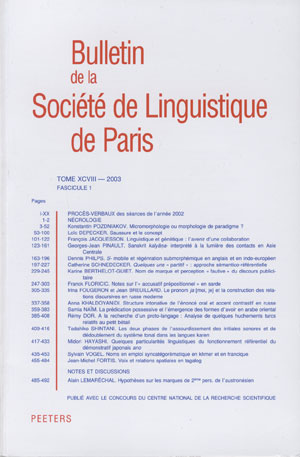 previous article in this issue previous article in this issue | next article in this issue  |

Preview first page |
Document Details : Title: Parties du discours et locutions Author(s): MEL'ČUK, Igor Journal: Bulletin de la Société de Linguistique de Paris Volume: 101 Issue: 1 Date: 2006 Pages: 29-65 DOI: 10.2143/BSL.101.1.2019821 Abstract : 1. Une locution est une unité lexicale, qui doit avoir son propre article de dictionnaire; dans la structure syntaxique profonde [= SSyntP] d’une phrase, elle occupe un seul noeud, mais correspond à un sous-arbre dans la SSynt de surface [= SSyntS], car à ce niveau, c’est un syntagme. Le problème se pose alors: comment, dans un dictionnaire grand public, assigner à une locution la partie du discours? 2. Les parties du discours [= PartDisc] sont discutées en termes généraux. Nous proposons de distinguer les PartDisc profondes (linguistiquement universelles) et les PartDisc de surface (caractéristiques d’une langue particulière); les deux sont les partitions des lexies selon les ensembles de règles linguistiques qui s’appliquent à ces lexies. De plus, il faut utiliser dans le dictionnaire les traits syntaxiques: les caractéristiques du comportement des lexies qui n’induisent pas leur partition mais spécifient, pour une lexie donnée, les constructions dans lesquelles elle peut apparaître. 3. Les PartDisc des lexies monolexémiques françaises sont décrites en termes de cinq PartDisc profondes et huit PartDisc de surface. 4. Étant une lexie multilexémique, c’est-à-dire un syntagme, une locution ne peut pas avoir une PartDisc de surface. Pour une locution, on indiquera donc sa pseudo-PartDisc de surface, c’est-à-dire sa caractéristique en tant que groupe syntaxique, et sa PartDisc profonde — sous forme d’expression «emploi X-al», où X est une Part-Disc profonde (par exemple, «emploi adverbial»). Ainsi, pour en miettes on écrira «groupe prépositionnel, emploi adjectival» (une voiture en miettes, La voiture était en miettes). 5. Certaines expressions phraséologisées (par exemple, de type en vain ou par contre) ne sont pas des locutions, mais des mots (historiquement) composés. Si on les considérait comme des locutions, leur SSyntS ne serait pas “normale”, en ce sens qu’elle ne pourrait pas être traitée par les règles générales de la langue. Un mot composé phraséologisé occupe un seul noeud dans la SSyntS de la phrase et est décrit dans le dictionnaire comme une lexie monolexémique. 6. Les locutions nominales et prépositionnelles employées adjectivalement (par exemple, voiture en miettes) sont opposées aux adjectifs invariables (par exemple, règle standard, copie pirate); des tests syntaxiques pour les adjectifs invariables du français sont introduits. 7. Pour illustrer nos propos, nous donnons une petite liste de locutions et de mots composés phraséologisés du français munis des informations sur leur PartDisc, du type proposé ci-dessus. 1. An idiom is a lexical unit [= LU] and must have its own lexical entry in the dictionary; in the Deep-Syntactic Structure [= DSyntS] of a sentence it occupies a single node, but corresponds to a sub-tree in the Surface SyntS [= SSyntS]—since at this level an idiom is a regular phrase. In this connection, the problem arises: How should one assign the part of speech to an idiom in a dictionary for the general public? 2. Parts of speech [= PartSp] are discussed in general terms. A distinction between Deep PartSp (language-universal) and Surface PartSp (language-specific) is proposed; both are strict partitions of LUs according to the sets of linguistic rules applicable to LUs. In addition, syntactic features are introduced to mark LUs in the dictionary; they characterize the syntactic behavior of LUs without partitioning them: a syntactic feature specifies, for an LU L, a set of constructions in which L can appear. 3. The PartSp of a one-word French LU is specified in terms of five Deep PartSp and eight Surface PartSp. 4. An idiom receives a pseudo-SPartSp, i.e., a characterization as a phrase, and a DPartSp in the form of an expression «used X-ally», where X is a Deep PartSp (e.g., «used adverbially»). Thus, en miettes ‘smashed to smithereens’ is encoded as «prepositional phrase, used adjectivally» (une voiture en miettes ‘car in smithereens’, La voiture était en miettes ‘The car was in smithereens’). 5. Some phraseological expressions are not idioms, but compound words (e.g., such as en vain ‘in vain’ or par contre ‘on the other hand’): if considered idioms, their SSyntS would not be ‘normal,’ in that it would not be processable by general rules of the language. A phraseologized compound is represented by a single node in the SSyntS of the sentence and is described in the dictionary as a oneword LU. 6. In French, nominal and prepositional idioms used adjectivally (e.g., voiture en miettes) contrast with invariable adjectives (e.g., règle standard ‘standard rule’, copie pirate ‘pirate copy’); some syntactic tests are introduced to identify invariable adjectives. 7. The claims made in the article are illustrated with a small list of French idioms and phraseologized compounds, supplied with PartSp indications as proposed. |
|


